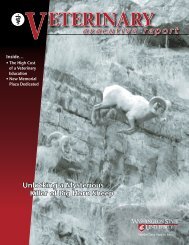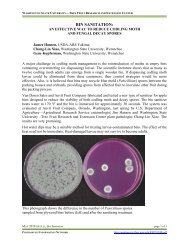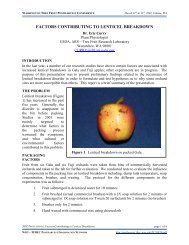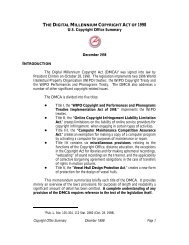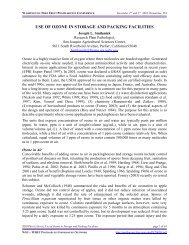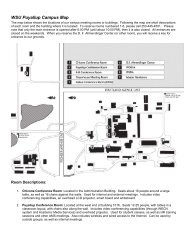2007 - Potatoes at WSU - Washington State University
2007 - Potatoes at WSU - Washington State University
2007 - Potatoes at WSU - Washington State University
Create successful ePaper yourself
Turn your PDF publications into a flip-book with our unique Google optimized e-Paper software.
<strong>2007</strong> Postharvest Procedures<br />
Early Harvest<br />
Testing of clones in the early harvest Tri-St<strong>at</strong>e and Regional Trials involved French frying samples <strong>at</strong><br />
harvest only, following the same procedure as used in the l<strong>at</strong>e harvest trials. In addition to French<br />
frying and chipping, culinary and quality characteristics of clones from the Red/Specialty Trial were<br />
evalu<strong>at</strong>ed after oven-baking, microwaving and boiling. Four- to six-ounce tubers were selected for<br />
the cooking protocols described below. After cooking, each tuber was halved from stem to bud end.<br />
One half was immedi<strong>at</strong>ely tasted and evalu<strong>at</strong>ed on a scale from 1 to 5 (5 is best) for texture, flavor,<br />
tuber center, and skin characteristics. The remaining half was incub<strong>at</strong>ed for 30 minutes <strong>at</strong> room<br />
temper<strong>at</strong>ure and after-cooking-darkening was then graded on a 1 to 5 scale based on a color chart<br />
for white- and yellow-fleshed clones (1 = excessive graying, 5 = no discolor<strong>at</strong>ion).<br />
Oven Baking - Tubers were pierced twice with a fork on each side and baked <strong>at</strong> 400°F for 1 hour.<br />
Boiling - Tubers were cooked in a sieved double-boiler for 1 hour after coming to a boil.<br />
Microwaving - Tubers were pierced twice with a fork on each side and cooked for 10 minutes <strong>at</strong> the<br />
outer edge of a microwave oven (high setting). The tubers were then turned over and moved to the<br />
center of the microwave where they were cooked an additional 10 minutes. Four-tuber samples from<br />
each of two clones (eight tubers total) were cooked simultaneously.<br />
Chipping - Tubers were cut longitudinally from stem to bud end. One half was used to make French<br />
fries as described below. The other half was sliced into 0.05-inch thick chips. The first slice was<br />
discarded to insure uniform thickness of the subsequent chips. The samples (12-tubers/clone) were<br />
rinsed with w<strong>at</strong>er and fried in 375°F vegetable oil for 2 minutes. The chips were drained on paper<br />
towels and chip color was graded using the Pot<strong>at</strong>o Chip/Snack Food Associ<strong>at</strong>ion (PC/SFA) color<br />
chart (1 = light, 5 = dark).<br />
L<strong>at</strong>e Harvest<br />
Testing of clones in the l<strong>at</strong>e harvest trials involved the following postharvest quality evalu<strong>at</strong>ions.<br />
As soon as possible after harvest, tuber specific gravity and fry color (Photovolt readings) were<br />
measured on 12 tubers from each clone. Clones design<strong>at</strong>ed as fresh processing were French fried<br />
and Photovolt readings compared <strong>at</strong> harvest only. Additional tubers of each clone were placed in<br />
storage <strong>at</strong> 40°, 44° and 48°F. Tubers stored <strong>at</strong> 48°F were evalu<strong>at</strong>ed for bruise potential, soft rot<br />
susceptibility, consumer acceptance of French fries, and cooking time in October and November.<br />
Reducing sugar content and French fry color were assessed in early December. The extent of<br />
sprouting was recorded in l<strong>at</strong>e December. Tubers stored <strong>at</strong> 44°F were also evalu<strong>at</strong>ed for sugar<br />
accumul<strong>at</strong>ion in December. Storage of tubers <strong>at</strong> 40°F until mid December was done to determine<br />
the “cold-frying” potential of clones. Fry color and reducing sugar content were assessed in these<br />
tubers but the results are not reflected in the final numerical r<strong>at</strong>ing for each clone (see below).<br />
St<strong>at</strong>istical Analysis<br />
Least significant difference (LSD) values are included in the tables to facilit<strong>at</strong>e evalu<strong>at</strong>ion of<br />
differences in fry color (Photovolt readings) and specific gravity among clones. Any two means<br />
whose difference is gre<strong>at</strong>er than or equal to the LSD value are significantly different. LSD values<br />
allow comparisons of the rel<strong>at</strong>ive performance of any two clones for a particular characteristic, such<br />
as fry color.<br />
<strong>2007</strong> Pot<strong>at</strong>o Cultivar Evalu<strong>at</strong>ions 6 <strong>WSU</strong> Pot<strong>at</strong>o Research Group



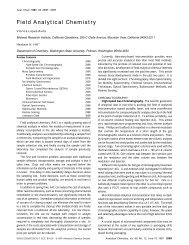
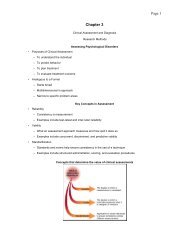
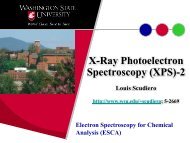

![Graduate School Policies & Procedures Manual 2011 - 2012 [PDF]](https://img.yumpu.com/50747405/1/190x245/graduate-school-policies-procedures-manual-2011-2012-pdf.jpg?quality=85)
